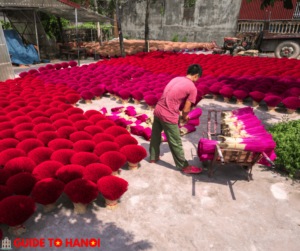Hang Trong Painting (Tu Thap village)
In the bustling streets of ancient Hanoi, amidst the rich tapestry of artisanal trades, one art form stood out for its exquisite beauty and cultural significance—Hang Trong painting (Hàng Trống painting).
Originally crafted in the historic land of Tu Thap village, this traditional Vietnamese folk art has a captivating history that beckons to be explored.
The Legacy of Hang Trong in Tu Thap Village
Hang Trong painting finds its roots in the heart of Tu Thap village, which was later absorbed into the fabric of Hanoi’s Hoan Kiem district.
Nestled alongside streets like Hang Non, Hang Hom, and Hang Quat, known for their craftsmanship, Hang Trong specialized in creating intricate worship items such as altar paintings, drums, fans, parasols, and flags.
A Glimpse into the Past: Hang Trong’s Historical Significance
The art of Hang Trong painting flourished around the 16th century, reaching its zenith in the late 19th and early 20th centuries.
However, as time passed, this art form gradually faded into obscurity, surviving only in the confines of museums.
Today, only one artist, Le Dinh Nghien, keeps the flame of Hang Trong paintings alive, embodying the essence of this unique style.
The Spiritual Essence: Themes of Hang Trong Paintings
Hang Trong paintings predominantly feature two themes: worship paintings and Tet paintings.
The former, used in religious practices, often depicts Taoist deities like Mother Lieu Hanh and includes intricate details like gold or silver carvings.
Tet paintings, on the other hand, include blessings and symbolic motifs like the Four Noble Phantasms.
Craftsmanship and Technique: The Art of Hang Trong Printing
The distinctive technique of Hang Trong painting involves a blend of printing and drawing.
The initial prints are made with lines and shapes, while colors are applied using a soft brush dipped in color and water, creating a unique play of hues.
Each painting undergoes a meticulous process, from printing and coloring to paper backing, taking several days to complete.
Colors of Tradition: Creating Vibrancy in Hang Trong Paintings
Hang Trong paintings are known for their vibrant colors, including shades of blue, pink, green, red, orange, and yellow.
The color combinations, while not strictly standardized, are carefully selected to amplify the visual allure and charm of the artwork.
Reviving a Cultural Treasure: Preserving Hang Trong Painting
Despite its decline, efforts are underway to revive the art of Hang Trong painting.
By preserving the techniques and craftsmanship of this traditional art form, we can ensure that its legacy continues to inspire future generations.
Experience the Timeless Beauty of Hang Trong
As you stroll along the streets of Hanoi, let yourself be enveloped by the rich history and cultural heritage embodied in Hang Trong painting.
Discover the artistry, craftsmanship, and spiritual essence that make Hang Trong a cultural treasure worth preserving.

By Unknown (traditional painting dated back to the 17th century) – http://www.tienphong.vn/Tianyon/Index.aspx?ArticleID=109817&ChannelID=15, Public Domain, https://commons.wikimedia.org/w/index.php?curid=9011132
| Aspect | Description |
|---|---|
| Origin | Hang Trong painting originated in Tu Thap village, later part of Hanoi’s Hoan Kiem district. |
| Themes | Hang Trong paintings feature worship themes and Tet (Lunar New Year) motifs, often with intricate details and vibrant colors. |
| Historical Significance | Believed to have appeared around the 16th century, flourishing in the late 19th and early 20th centuries before gradually declining. |
| Technique | Hang Trong paintings use a half-printing, half-drawing technique with colors applied using a brush dipped in color and water. |
| Colors | Colors used in Hang Trong paintings include blue, pink, green, red, orange, and yellow, chosen for their visual appeal. |
| Revival Efforts | Efforts are underway to revive the art of Hang Trong painting and preserve its techniques and craftsmanship. |




